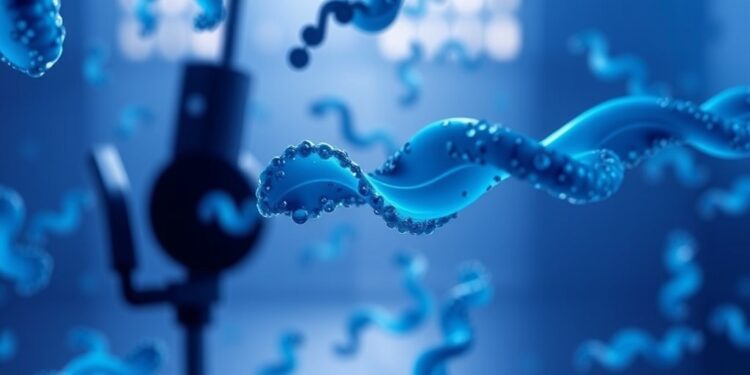
Oxytocin, often dubbed the “love hormone,” has always been associated with various essential processes in mammals such as childbirth, lactation, and the formation of crucial bonding between a mother and her offspring. However, groundbreaking research has brought to light a previously unrecognized role of this hormone in the intricate web of mammalian reproduction. A monumental study conducted by researchers at NYU Langone Health has unveiled that under conditions of maternal stress, oxytocin may induce a state called diapause—an early embryonic pause that can extend from several days to weeks post-conception.
Diapause, an adaptive strategy observed in several mammalian species, allows an embryo to temporarily halt development during critical periods. This phenomenon has been intricately linked to the evolutionary need for mothers to conserve resources when environmental conditions are suboptimal for nurturing offspring. The phenomenon is not limited to rodents; it spans a diverse array of animals, including armadillos, giant pandas, and seals. It stands as a remarkable testament to evolution’s deeply ingrained mechanisms aimed at guarding the survival of future generations.
Despite existing knowledge about other mammals exhibiting diapause, the initial insights into such a process happening in humans have stirred curiosity. Yet, the cellular and molecular processes that bring about this phenomenon in humans and other species have remained largely enigmatic—until now. The latest findings highlight that a specific type of stress, particularly during lactation, prompts a rise in oxytocin levels, which in turn leads to delays in gestation. For instance, rodent models demonstrated an observable postponement in gestation periods, extending approximately seven days when the mother was simultaneously nursing a litter.
This delay is critical, as it emphasizes how maternal physiological states can directly influence embryonic development. The research teams determined that oxytocin’s role in delaying implantation in the uterus is noteworthy. Experimental exposure of mouse embryos to controlled doses of this hormone demonstrated that even minimal quantities were sufficient to disrupt the normal timeline of implantation, a pivotal step in establishing a successful pregnancy. In instances where larger surges of oxytocin were administered, adverse outcomes were noted, frequently resulting in pregnancy loss.
The research led by Dr. Moses Chao identified the intricate relationship between lactation and embryo development through more than mere observation. By isolating the hormonal responses involved, the team uncovered that heightened levels of oxytocin can significantly shift the typical framework of gestation. Although it may appear that this pause is detrimental, the strategic timing can help ensure successful nurturing of the existing offspring, thus preserving maternal resources.
Understanding the fundamental mechanisms underlying diapause may have profound implications for human reproductive health. As Dr. Chao notes, abnormalities in oxytocin production might contribute to various reproductive challenges such as infertility, miscarriages, and issues with timely births. Hence, the significance of this study transcends its initial rodent findings, prompting further inquiries into its relevance within human physiology.
A deeper dive into the molecular biology of this process revealed that oxytocin acts by binding to specific receptors located on the trophectoderm—a layer of cells surrounding the early embryo that plays a crucial role in forming the placenta. This interaction appears essential for the embryo’s ability to sense and respond to maternal conditions and stressors. Experiments revealing that genetically modified mouse embryos lacking oxytocin receptors exhibited significantly reduced rates of implantation underscore the hormone’s vital role in safeguarding the embryo’s journey toward successful gestation.
While notable, researchers caution against oversimplifying cross-species application. The reproductive processes differ fundamentally between mice and humans, meaning the findings must be contextualized within their specific biological frameworks. The complexities of reproductive hormones—like estrogen and progesterone—also play roles in these dynamics. Continual exploration into how hormones interact during pregnancy will be pivotal in bridging the gaps between animal models and human reproductive issues.
The ramifications of this research are potent; infertility and reproductive challenges are distressingly common and carry extensive emotional burdens. By unraveling the interplay of hormones like oxytocin, researchers aim to empower medical professionals with enhanced tools and understanding to tackle such prevalent issues. A more profound comprehension of factors contributing to reproductive and developmental problems could pave the way for innovative interventions in reproductive medicine, a desperately needed advance in an area that has long relied on trial and error.
In the pursuit of further knowledge, plans are afoot to investigate how cellular growth is reactivated following periods of diapause. Further revelations on how delayed embryonic development impacts offspring health post-birth will constitute the next stage of study, potentially revealing links between maternal reproductive strategies and long-term health of progeny—a nexus that could inform new pathways in prenatal and postnatal care.
Ultimately, the study stands as a testament to how working on fundamental biological questions can yield insights with far-reaching implications in reproductive health. By taking a closer look at the nuances of oxytocin’s role in diapause, researchers open avenues for understanding infertility and other gestational challenges, paving the way for technological innovations and enhanced patient outcomes in women’s health.
The results of the study were published on March 5 in the esteemed journal Science Advances, embedding these findings in the continuum of knowledge that seeks to address and ameliorate the complexities surrounding human reproduction. The collaboration and expertise of numerous researchers underline the joint effort to unravel this intricate biological narrative, reinforcing a commitment to enhancing women’s health through innovative scientific research.
Subject of Research: Oxytocin’s Role in Embryonic Diapause
Article Title: Oxytocin induces embryonic diapause
News Publication Date: 5-Mar-2025
Web References: Link to DOI
References: None provided
Image Credits: None provided
Keywords: Oxytocin, Embryonic Development, Diapause, Reproductive Biology, Pregnancy, Women’s Health, Infertility, Hormones, Lactation, Maternal-Fetal Interaction, Developmental Biology, Stress Response.
Tags: bonding hormone in mammalsconservation of resources in reproductiondiapause in mammalsembryonic development pauseevolutionary adaptations in reproductionimplications for human infertilitymammalian species diapausematernal infertility researchmaternal stress effectsNYU Langone Health studyoxytocin’s role in reproductionunderstanding maternal health





